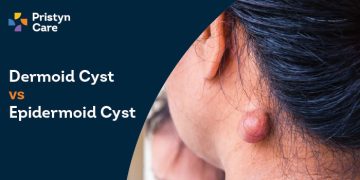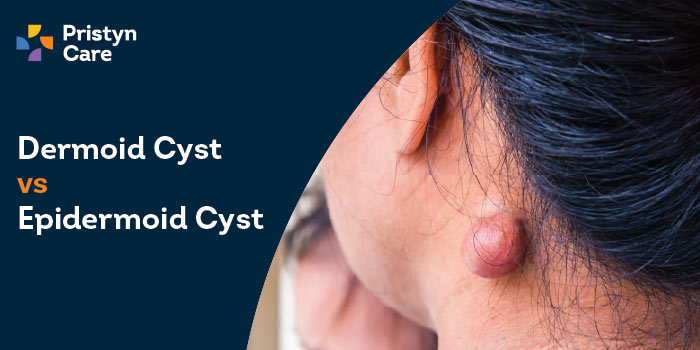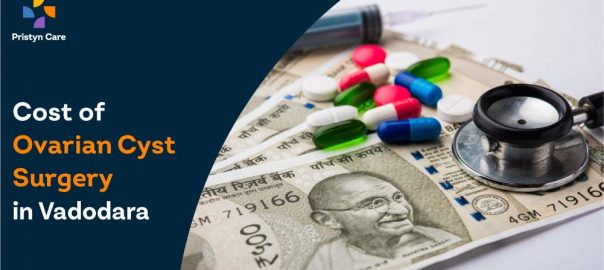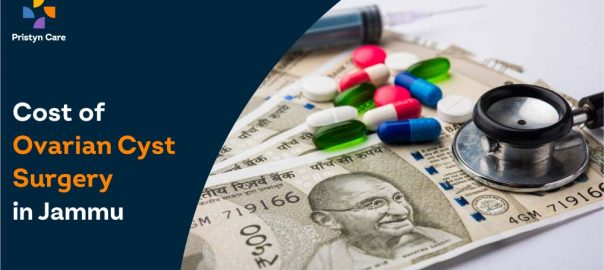![]() Views: 877
Views: 877
Dermoid Cyst vs Epidermoid Cyst
Dedicated Support at Every Step!
Our Doctors are available 24 hours a day, 7 days a week to help you!
Table of Contents
Understanding Cysts
Cysts are closed sac-like structures that can form in various tissues throughout your body. They typically contain fluid, semi-solid material, or gas and can significantly vary in size. Their formation often occurs due to a blockage in the gland or duct's drainage, abnormal tissue growth, or infection. Here are some general characteristics of cysts:
- Encapsulation: Most cysts are encapsulated by a thin layer of tissue.
- Contents: The contents can include pus, fluid, or keratin.
- Growth Patterns: Cysts can grow slowly over time and may become symptomatic if they compress surrounding structures.
No Cost EMI, Hassle-free Insurance Approval
Dermoid Cysts: An Overview
Dermoid cysts are unusual growths that comprise a mixture of tissues, including hair follicles, sebaceous glands, and occasionally, teeth or nerve tissue. They are most commonly located in the head, neck, and ovaries, but can potentially develop anywhere within the body. The formation of these cysts is associated with germ cells from embryonic development, and they are often present at birth or may emerge shortly thereafter.
Epidermoid Cysts: A Closer Look
Unlike dermoid cysts, epidermoid cysts are more prevalent and primarily composed of keratinised epithelial cells. They typically appear as small, round lumps under the skin and are often found on the face, neck, and trunk. Notably, epidermoid cysts do not contain skin appendages such as hair follicles or sebaceous glands, which sets them apart from dermoid cysts. Epidermoid cysts hold several distinct characteristics:
- They are lined by simple squamous epithelium.
- They contain keratin and cellular debris.
- They lack the complex structures that we see in dermoid cysts.
The development of epidermoid cysts can be attributed to a number of factors, including trauma or inflammation; however, they can also arise without any apparent trigger.
Comparing Dermoid and Epidermoid Cysts
If you were to consider the dermoid cyst versus the epidermoid cyst, you would notice several significant differences.
- Dermoid cysts originate from germ cells and may contain a variety of tissue types, like hair follicles and sebaceous glands. They are typically found in areas such as the head, neck, and ovaries. Histologically, dermoid cysts present a complex structure with skin appendages.
- Epidermoid cysts have an ectodermal inclusion origin, and their contents mainly consist of keratinised epithelial cells. They commonly occur on the face, neck, and trunk. Unlike dermoid cysts, they reveal a simpler nature under histological examination with their simple squamous epithelium.
In terms of clinical presentation, both types of cysts often appear as minimal pain masses. However, dermoid cysts may cause pressure symptoms in some instances and can sometimes lead to complications such as infection or rupture, if they are near vital structures.
Diagnostic Measures
Determining whether a patient has a dermoid or an epidermoid cyst usually involves medical imaging techniques and biopsy procedures.
- For initial evaluation, an ultrasound is often used. This technique shows fluid-filled masses that can help identify the presence of a cyst.
- For a more detailed look at the characteristics of the cyst, MRI (magnetic resonance imaging) comes into play. Dermoid cysts often appear hyperintense on T1-weighted images due to their fat content. In contrast, epidermoid cysts show restricted diffusion patterns.
In some cases, however, these imaging techniques may not be enough for a conclusive diagnosis. Therefore, a biopsy might be necessary to confirm the diagnosis histologically. This process involves removing a small sample of tissue for microscopic examination to identify the specific type of cyst based on its cellular composition.
Treatment Options and Prognosis
When it comes to managing both dermoid and epidermoid cysts, a range of treatment options are available.
- If symptoms are present or there is a risk of malignancy, your doctor may recommend surgical removal, which is the most common treatment approach for these cysts. With advancements in medical science, minimally invasive techniques are often used, depending on the location of the cyst.
- For asymptomatic patients, careful observation may be the suitable course of action. In situations where there is an infection, a doctor might perform a drainage procedure, but this isn't curative and may not permanently resolve the issue.
Prognosis
With appropriate treatment, patients with either type of cyst generally have a good outlook. Recurrences are rare but can happen if the entire cyst wall is not completely removed during the operation.
Understanding the difference between dermoid and epidermoid cysts is crucial for effective clinical management. These cysts have unique characteristics that assist in accurate diagnosis and planning the right treatment approach. Early detection plays a significant role too; it can prevent complications such as infection or rupture that might negatively impact your quality of life. Hence, developing an ability to differentiate between these two types of cysts enables doctors to ensure better patient outcomes.
FAQs
1. What causes a dermoid cyst or an epidermoid cyst?
Dermoid cysts are congenital, which means they form during the development of the foetus in the womb. Epidermoid cysts, however, usually form due to injury or damaged hair follicles.
2. Can both dermoid and epidermoid cysts occur anywhere on the body?
While both types of cysts can basically occur anywhere on the body, they most commonly appear in certain areas. Epidermoid cysts are usually found on the face, neck, back, or genitals, whereas dermoid cysts are commonly found on the face, inside the skull, on the lower back, or ovaries.
3. Is there any difference in the treatment for a dermoid cyst vs epidermoid cyst?
Both types of cyst may be removed through a minor surgical procedure if they cause discomfort or cosmetic concern. However, it is essential to consult with your family doctor to discuss the best treatment option for your specific condition.
4. Are there any noticeable symptoms for both dermoid and epidermoid cysts?
Both types of cysts can be symptomless in their early stages. However, as they grow larger, they may cause discomfort or pressure symptoms. Epidermoid cysts are often noticeable as small lumps under the skin that may become inflamed or infected. Dermoid cysts may cause more serious symptoms if they press against nerves or disrupt organ function.
5. Is there a familial tendency for dermoid or epidermoid cysts?
While dermoid cysts are congenital and not typically linked to genetics, some research suggests that epidermoid cysts might have a genetic component. If you have a family history of such cysts, it is important to let your doctor know.
6. Do both dermoid and epidermoid cysts pose a risk for cancer?
While both dermoid cysts and epidermoid cysts are typically benign, in very rare cases, they can become cancerous. However, this risk is extremely low.
7. Is the recurrence rate of dermoid cysts and epidermoid cysts the same?
The recurrence rate of these cysts may vary. Epidermoid cysts have a higher chance of recurrence if not completely removed. Dermoid cysts, on the other hand, typically do not recur after complete surgical removal.
8. How do dermoid and epidermoid cysts affect pregnancy?
Dermoid cysts can cause complications during pregnancy if they twist or rupture. Epidermoid cysts generally do not affect pregnancy unless they become infected or inflamed.
9. Do dermoid or epidermoid cysts cause pain?
Typically, these cysts are minimal pain. However, if they become infected or rupture, they can cause discomfort and pain.
10. Can lifestyle changes help in managing dermoid and epidermoid cysts?
While lifestyle changes will not prevent these cysts, maintaining a good hygiene routine can help prevent infections in epidermoid cysts. Regular health checks can also aid in early detection and treatment of both dermoid and epidermoid cysts.












